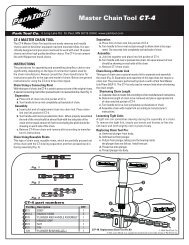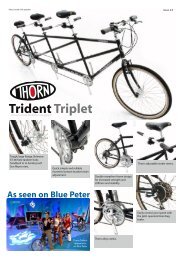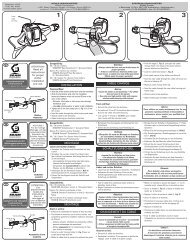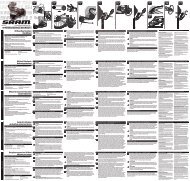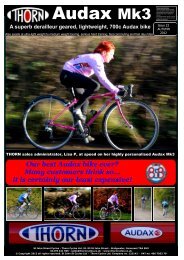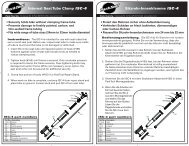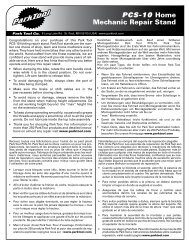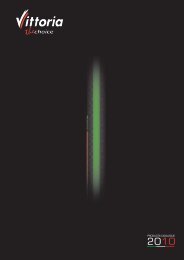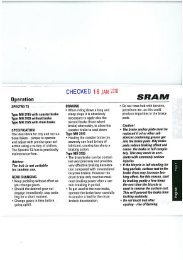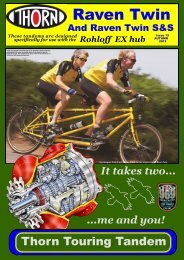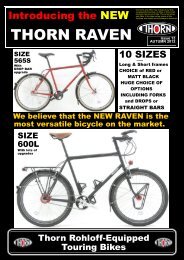You also want an ePaper? Increase the reach of your titles
YUMPU automatically turns print PDFs into web optimized ePapers that Google loves.
Butterfly bars<br />
(Modolo Yuma bars)<br />
“Butterfly” bars are very popular in Northern<br />
Europe, which is blessed with an abundance of high<br />
quality, flat cycle paths and also with drivers who have<br />
a courteous attitude towards cyclists. They appear, at<br />
first, to offer many different positions. The most important<br />
position, the one that gives you access to the brakes, is a<br />
very narrow position. If you ride, for any distance, with the<br />
outside of your hands pressing against the inside curve of<br />
these bars, you will find it very uncomfortable.<br />
In heavy traffic, the narrow position offered, when covering<br />
the brakes, cannot be used to advantage, when filtering<br />
through slow moving or stationary vehicles, because the<br />
overall width of these bars is very wide. On loose, greasy or<br />
icy surfaces a bike is much easier to control if it has wide<br />
bars but with these bars, the brakes can only be reached<br />
from the narrow position.<br />
Butterfly bars are made from a very long length of tubing<br />
and consequently the bars flex significantly, when the<br />
“access to brakes” position is used.<br />
Flexing is a positive thing, when riding slowly on flat cycle<br />
paths, it enhances comfort. At high speed, down mountain<br />
roads (or hilly country lanes) the flexing of the bars<br />
becomes alarming; yet you must hold them here, because,<br />
yet again this is where the brakes are!<br />
A bike, designed for drop handlebars, needs a shorter top<br />
tube than a bike which is designed for “straight” handlebars.<br />
The reason is simple...drop bars have a pronounced<br />
forward throw, straight bars have no such throw (they<br />
usually sweep back, towards the rider.) When cycling on<br />
drop bars, using the brake hood position, the rider’s hands<br />
are even further forward. The designer of a well designed<br />
drop bar bike, will know that this is where a riders hands<br />
are, most of the time and will have taken this into account,<br />
by providing a suitably short top tube.<br />
When drop bars are used on a bike which has been<br />
correctly designed for straight bars, they will grossly<br />
overstretch the rider. I have found that generally, the stem<br />
length needs to be reduced by around 60 to 70mm, when<br />
moving from straights to drops on the same frame. As most<br />
straight bar bikes are designed for use with a stem of from<br />
100 to 120mm, drop bars would generally mean fitting a<br />
stem between 30 to 60mm. This is far from ideal.<br />
Conversely, a frame<br />
The choice of bar<br />
affects frame design<br />
and vice-versa.<br />
5<br />
The NEW RAVEN<br />
which was fine with<br />
drop bars would need<br />
a 60-70mm longer<br />
stem to achieve a<br />
comfortable position<br />
with straight bars. Really long stems, used with straight<br />
bars, have a terrible effect upon the steering, making it feel<br />
like a tiller!<br />
Butterfly bars bend deeply, back towards the rider, therefore<br />
the stem must be long enough (at least 120mm but 130mm<br />
would be better) to place the brake position, forward of the<br />
“centre of steering”.<br />
If you ride with your hands behind the centre of steering,<br />
you run the risk of, not only being unable to control a speed<br />
wobble but of actually precipitating one in the first place!<br />
Given the absolute necessity of using a long stem with<br />
butterfly bars, If you select a frame which is ideal for you<br />
with butterfly bars, the frame will be too short, if you decide<br />
that straight bars with bar ends, or comfort bars, are a<br />
better idea. It is almost ironic that butterfly bars, which<br />
appear to offer such a wide choice of position, are usually<br />
unable to provide comfort, in the position that you have to<br />
use, for much of the time, in order to operate the brakes!<br />
Straight bars and<br />
comfort bars, need to<br />
be used with frames<br />
with long top tubes.<br />
I hope that I have<br />
been able to explain<br />
why we believe that<br />
it is so important to<br />
choose your bars<br />
before you choose<br />
your frame.<br />
We also believe that a frame alleged to be suitable for<br />
all types of bar, is unlikely to be satisfactory with any<br />
type of bar!<br />
Rohloff only manufacture one type<br />
of shifter…a twist grip which only<br />
fits onto 22.2mm dia. bars.<br />
The shifter is normally fitted to the RIGHT<br />
side of the bar but it’s now also available to<br />
fit onto the LEFT side of the bar.<br />
The Rohloff shifter is round in section, it is<br />
easy to grip and easy to rotate. The indexing<br />
of the Rohloff hub takes place within the hub<br />
and the shifter is very easily turned.<br />
Many people have tried and found that they don’t like<br />
“Gripshift”. If this is a worry, I’d like to reassure you<br />
that the Rohloff shifter is something completely<br />
different. Derailleur specific “Gripshifters” have a very<br />
stiff, yet vague action, which is not helped by the fact<br />
that the shifter is difficult to grip.<br />
We use standard grips and cut the shifter-side grip*<br />
down to suit.<br />
Recently, the French engineer, Gilles<br />
Berthoud has introduced a shifter which<br />
will work on drop bars.<br />
This shifter is manufactured in 3 sections, which<br />
can be manoeuvred around the bends of drop bars<br />
and assembled in situ.<br />
Gilles worked in close collaboration with Rohloff,<br />
who have given their approval for its use.<br />
STOP PRESS!<br />
We have had our own THORN DROP<br />
BARS made for Rohloff.<br />
Look how close we’ve managed to get<br />
the GB shifter to the stem!<br />
This creates sufficient room “on the<br />
tops” for a comfortable hand position.<br />
NEW THORN RAVEN<br />
Issue 13 – AUTUMN 2012<br />
The Rohloff shifter is normally fitted to the RHS<br />
but you can request it to be fitted to the<br />
LHS...PLEASE MAKE THIS VERY CLEAR<br />
WHEN ORDERING THE BIKE.<br />
We fit Herrmans grips as standard equipment but the<br />
upgrade to Ergon GP1-L grips is very highly<br />
recommended.<br />
All drop bars are 23.4mm in diameter, irrespective of<br />
the diameter of the centre swell; whereas all straight<br />
bars are 22.2mm in diameter.<br />
5



